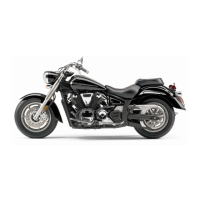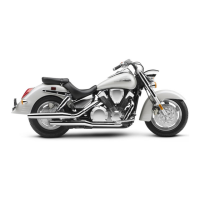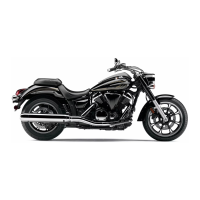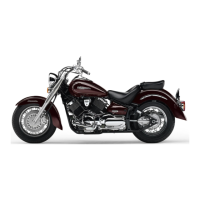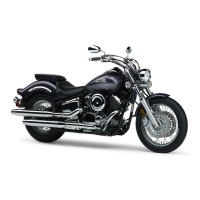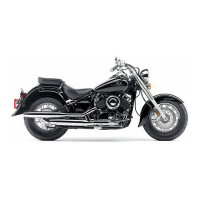
Do you have a question about the Yamaha V-stan 1300 XVS13AX and is the answer not in the manual?
| Engine Type | V-twin |
|---|---|
| Bore x Stroke | 100.0mm x 83.0mm |
| Compression Ratio | 9.5:1 |
| Fuel System | Fuel injection |
| Ignition | TCI |
| Transmission | 5-speed |
| Final Drive | Belt |
| Front Suspension | Telescopic fork |
| Front Tire | 130/90-16 |
| Rear Suspension | Single shock |
| Front Brake | Dual disc |
| Rear Brake | Single disc |
| Overall Length | 98.0 in |
| Overall Height | 1145 mm |
| Fuel Capacity | 17.0 liters |
Details critical labels on the vehicle for safe operation and understanding.
Provides essential data on tire pressure and inspection for safe riding.
Identifies and explains components and controls on the left side of the motorcycle.
Identifies and explains components and controls on the right side of the motorcycle.
Details the handlebar controls and instrument panel layout for operation.
Explains the operation and positions of the main switch and steering lock.
Describes the function and meaning of various dashboard indicator and warning lights.
Details the features and operation of the speedometer, odometer, and other display functions.
Explains the function and operation of various switches located on the handlebars.
Details the operation, adjustment, and related switch for the clutch lever.
Explains the operation and gear shifting procedure using the shift pedal.
Details the operation and adjustment of the front brake lever.
Explains the operation of the rear brake pedal.
Provides instructions for opening and closing the fuel tank cap.
Covers recommended fuel types, capacity, and important cautions for refueling.
Explains the function of the catalytic converter and necessary precautions.
Details how to remove and install the rider seat for access.
Explains the location and use of the helmet holder under the seat.
Describes how to adjust the spring preload for ride comfort and handling.
Explains the location and operation of the sidestand, including its switch.
Details the safety system that prevents starting under certain conditions.
A comprehensive list of daily checks for fuel, oil, brakes, tires, and lights for safe operation.
Guides on how to start the engine safely, considering ignition system functions.
Explains how to shift gears for optimal performance and control, including speed points.
Provides critical guidelines for the initial 1600 km to ensure engine longevity.
Offers advice on how to park the motorcycle safely, considering hot components and stability.
Identifies the included tool kit for basic maintenance and minor repairs.
Outlines scheduled maintenance tasks specifically for the emission control system.
A comprehensive chart detailing regular maintenance and lubrication intervals for various components.
Instructions on how to remove and install a specific panel for maintenance access.
Guides on inspecting spark plugs to assess engine condition and ensure proper function.
Describes the function and checks for the evaporative emission control canister.
Details procedures for checking engine oil level and replacing the oil filter.
Explains how to check coolant level and add coolant if necessary.
Provides steps for replacing the air filter element to maintain engine performance.
Instructions for checking and adjusting the throttle cable for smooth operation.
Explains the importance of valve clearance and when it should be adjusted.
Covers tire pressure, inspection, and replacement guidelines for safety and performance.
Details checks for wheel integrity, balance, and proper tire mounting after replacement.
Advises on selecting and installing accessories and replacement parts for safety.
Step-by-step guide to adjust the clutch lever free play for optimal engagement.
Instructions for adjusting the front brake lever free play for proper braking response.
Explains how to adjust the rear brake light switch for correct activation timing.
Guides on inspecting brake pads for wear and determining when replacement is needed.
Details on checking brake fluid levels and the implications of low fluid.
Outlines the recommended intervals and procedures for changing brake fluid.
Explains how to check and adjust the drive belt tension for optimal performance.
Guides on inspecting and lubricating control cables for smooth operation.
Details on checking throttle operation and lubricating the grip and cable.
Explains how to check pedal operation and lubricate pivot points.
Guides on checking lever operation and lubricating pivot points.
Explains how to check sidestand operation and lubricate its pivot.
Details on lubricating the swingarm pivot points at specified intervals.
Explains how to lubricate the rear suspension pivot points.
Guides on inspecting the front fork for damage and smooth operation.
Details on checking steering bearings for looseness or wear.
Explains how to check front and rear wheel bearings for play or smooth operation.
Provides information on the sealed-type battery and its maintenance requirements.
Step-by-step instructions for replacing blown fuses in the electrical system.
Guides on how to replace the headlight bulb, including safety precautions.
Instructions for replacing the tail and brake light bulbs.
Guides on replacing the front turn signal light bulb.
Instructions for replacing the rear turn signal light bulb.
Details on replacing the license plate light bulb.
Precautions and methods for safely supporting the motorcycle during maintenance.
General advice on identifying and resolving common operational problems.
Provides diagnostic charts for starting issues, compression, ignition, and battery problems.
Explains how to diagnose and address engine overheating issues safely.
Advises on proper cleaning products for matte finish parts to avoid damage.
General guidance on cleaning the motorcycle to maintain appearance and performance.
Provides instructions for short-term and long-term motorcycle storage to protect it.
Instructions for recording key, vehicle, and model identification numbers for reference.
Explains the location and importance of the model label for ordering parts.
Guidance on reporting vehicle safety defects to NHTSA and Yamaha.
Information on federal laws prohibiting tampering with noise control systems.
A chart to document completed maintenance services for warranty purposes.
Addresses common customer queries regarding warranty coverage, responsibilities, and procedures.
Provides contact information and guidance for obtaining warranty service and assistance.
Details the benefits and options for Yamaha's extended service plan for vehicle protection.
